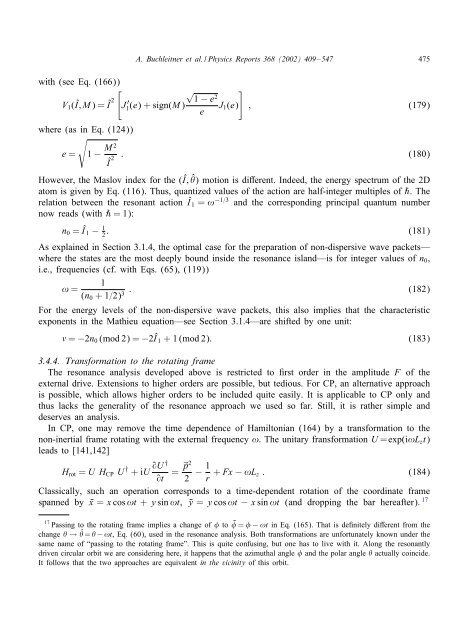Non-dispersive wave packets in periodically driven quantum systems
Non-dispersive wave packets in periodically driven quantum systems
Non-dispersive wave packets in periodically driven quantum systems
Create successful ePaper yourself
Turn your PDF publications into a flip-book with our unique Google optimized e-Paper software.
A. Buchleitner et al. / Physics Reports 368 (2002) 409–547 475<br />
with (see Eq. (166))<br />
V1(Î;M)=Î 2<br />
<br />
J ′ √ <br />
1 − e2 1(e) + sign(M) J1(e) ;<br />
e<br />
where (as <strong>in</strong> Eq. (124))<br />
<br />
(179)<br />
e =<br />
M 2<br />
1 −<br />
Î 2 : (180)<br />
However, the Maslov <strong>in</strong>dex for the (Î; ˆ ) motion is di erent. Indeed, the energy spectrum of the 2D<br />
atom is given by Eq. (116). Thus, quantized values of the action are half-<strong>in</strong>teger multiples of ˝. The<br />
relation between the resonant action Î 1 = ! −1=3 and the correspond<strong>in</strong>g pr<strong>in</strong>cipal <strong>quantum</strong> number<br />
now reads (with ˝ = 1):<br />
n0 = Î 1 − 1:<br />
(181)<br />
2<br />
As expla<strong>in</strong>ed <strong>in</strong> Section 3.1.4, the optimal case for the preparation of non-<strong>dispersive</strong> <strong>wave</strong> <strong>packets</strong>—<br />
where the states are the most deeply bound <strong>in</strong>side the resonance island—is for <strong>in</strong>teger values of n0,<br />
i.e., frequencies (cf. with Eqs. (65), (119))<br />
1<br />
! =<br />
: (182)<br />
(n0 +1=2) 3<br />
For the energy levels of the non-<strong>dispersive</strong> <strong>wave</strong> <strong>packets</strong>, this also implies that the characteristic<br />
exponents <strong>in</strong> the Mathieu equation—see Section 3.1.4—are shifted by one unit:<br />
= −2n0 (mod 2) = −2Î 1 + 1 (mod 2): (183)<br />
3.4.4. Transformation to the rotat<strong>in</strong>g frame<br />
The resonance analysis developed above is restricted to rst order <strong>in</strong> the amplitude F of the<br />
external drive. Extensions to higher orders are possible, but tedious. For CP, an alternative approach<br />
is possible, which allows higher orders to be <strong>in</strong>cluded quite easily. It is applicable to CP only and<br />
thus lacks the generality of the resonance approach we used so far. Still, it is rather simple and<br />
deserves an analysis.<br />
In CP, one may remove the time dependence of Hamiltonian (164) by a transformation to the<br />
non-<strong>in</strong>ertial frame rotat<strong>in</strong>g with the external frequency !. The unitary fransformation U =exp(i!Lzt)<br />
leads to [141,142]<br />
Hrot = UHCP U † 9U † ˜p2 1<br />
+iU = −<br />
9t 2 r + Fx − !Lz : (184)<br />
Classically, such an operation corresponds to a time-dependent rotation of the coord<strong>in</strong>ate frame<br />
spanned by x = x cos !t + y s<strong>in</strong> !t, y = y cos !t − x s<strong>in</strong> !t (and dropp<strong>in</strong>g the bar hereafter). 17<br />
17 Pass<strong>in</strong>g to the rotat<strong>in</strong>g frame implies a change of to = − !t <strong>in</strong> Eq. (165). That is de nitely di erent from the<br />
change → ˆ = − !t, Eq. (60), used <strong>in</strong> the resonance analysis. Both transformations are unfortunately known under the<br />
same name of “pass<strong>in</strong>g to the rotat<strong>in</strong>g frame”. This is quite confus<strong>in</strong>g, but one has to live with it. Along the resonantly<br />
<strong>driven</strong> circular orbit we are consider<strong>in</strong>g here, it happens that the azimuthal angle and the polar angle actually co<strong>in</strong>cide.<br />
It follows that the two approaches are equivalent <strong>in</strong> the vic<strong>in</strong>ity of this orbit.











